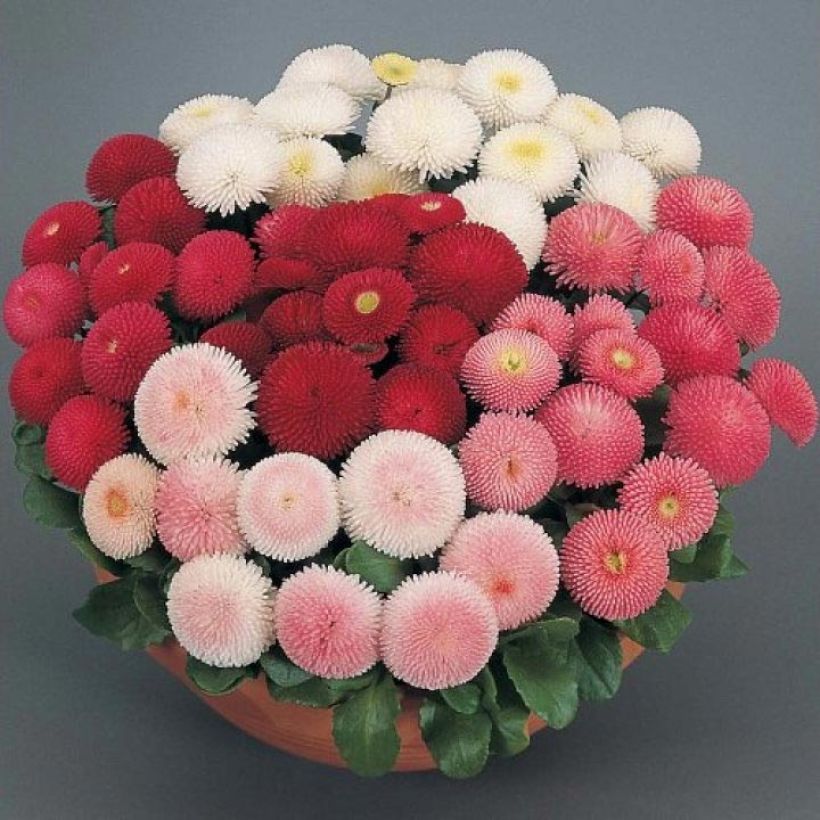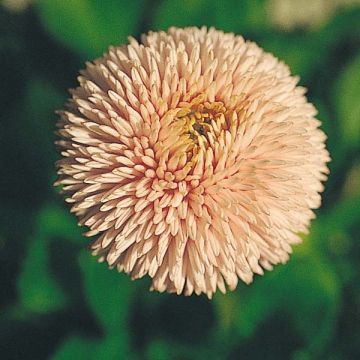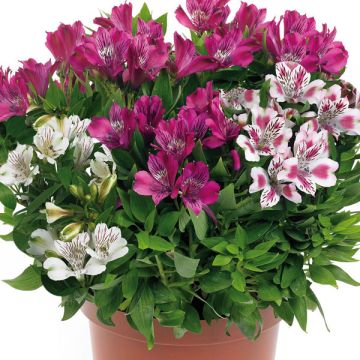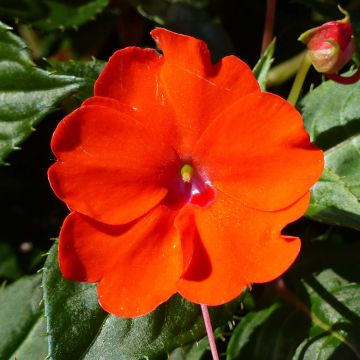

Tasso Daisy in mini-plug mix - Bellis Perennis


Tasso Daisy in mini-plug mix - Bellis Perennis
Tasso Daisy in mini-plug mix - Bellis Perennis
Bellis perennis Tasso
Common Daisy, Lawn Daisy, English Daisy
Very pretty, last a long time.
Martine, 12/04/2023
This plant carries a 6 months recovery warranty
More information
We guarantee the quality of our plants for a full growing cycle, and will replace at our expense any plant that fails to recover under normal climatic and planting conditions.
From €5.90 for pickup delivery and €6.90 for home delivery
Express home delivery from €8.90.
From €5.90 for pickup delivery and €6.90 for home delivery
Express home delivery from €8.90.
From €5.90 for pickup delivery and €6.90 for home delivery
Express home delivery from €8.90.
From €5.90 for pickup delivery and €6.90 for home delivery
Express home delivery from €8.90.
Delivery to Corse prohibited: UE law prohibits the import of this plant from mainland France to Corse as part of the fight against Xylella fastidiosa. Please accept our sincere apologies.
More information

Does this plant fit my garden?
Set up your Plantfit profile →
Description
Tasso Mix Daisies, also known as Bellis perennis, are the perfect allies to brighten up spring. The early pompom blooms of this biennial come in delicious pastel candy colorsof white, pink, red and cheerfully animate balconies and flower borders. Hardy and floriferous, this mix gives a harmonious accompaniment to spring bulbs.
Belonging to the Asteraceae family, daisies represent innocence and attachment in the language of flowers - hence their attraction for children and our desire to scatter them throughout the garden to welcome in the spring.
Originally a perennial plant, used as a biennial, it prefers moist but well-drained soil. Its size (15 cm / 5.9 in) allows it to fit at the edge of flowerbeds in front of narcissi and tulips, but you can also find a place for it among pansies and forget-me-nots in pots and containers. Their base consists of a rosette of dark green leaves, from which multiple pilous stems emerge, bearing a single flower at their top. These flowers, in the form of pompoms, are both simple and impressive: they are small, slightly flattened balls (3 cm (1.2 in) in diameter), made up of multiple very fine petals, positioned very densely with geometric regularity. At the start of blooming their tiny yellow heart is barely visible. If grown without chemical treatment you can even consume them - try sprinkling dishes with these little coloured filaments.
The Bellis perennis live up to their name, which means "eternal beauties". They will keep you company from February to May and their colours, both soft and vibrant, will complete the full palette of spring flowers. They fit effortlessly in every corner of the garden and can fill in spaces in arrangements.
Note: Please be aware that our young plants in mini-plugs are professional products intended for experienced gardeners: upon receipt, transplant them as soon as possible into pots or containers, or directly into flower beds.
Report an error about the product description
Tasso Daisy in mini-plug mix - Bellis Perennis in pictures


Flowering
Foliage
Plant habit
Botanical data
Bellis
perennis
Tasso
Asteraceae
Common Daisy, Lawn Daisy, English Daisy
Other Daisies
Planting and care
These daisy plug plants need to be transplanted directly into pots or planters as soon as they are received. Monitor moisture levels and regularly apply fertiliser (about twice a month). They prefer full sun or partial shade.
If you wish to plant them in the ground, transplant them first into pots. Monitor watering, taking care not to saturate the soil. No need to keep them in a greenhouse, they will be happy with a sheltered spot. In September or even October they can be transplanted directly into their final position.
Slugs and snails are fond of their young shoots, protect with a ring of ash scattered around the base.
By removing faded flowers you will encourage the growth of new buds.
Planting period
Intended location
Care
-
, onOrder confirmed
Reply from on Promesse de fleurs
Plug plants - Annuals
Haven't found what you were looking for?
Hardiness is the lowest winter temperature a plant can endure without suffering serious damage or even dying. However, hardiness is affected by location (a sheltered area, such as a patio), protection (winter cover) and soil type (hardiness is improved by well-drained soil).

Photo Sharing Terms & Conditions
In order to encourage gardeners to interact and share their experiences, Promesse de fleurs offers various media enabling content to be uploaded onto its Site - in particular via the ‘Photo sharing’ module.
The User agrees to refrain from:
- Posting any content that is illegal, prejudicial, insulting, racist, inciteful to hatred, revisionist, contrary to public decency, that infringes on privacy or on the privacy rights of third parties, in particular the publicity rights of persons and goods, intellectual property rights, or the right to privacy.
- Submitting content on behalf of a third party;
- Impersonate the identity of a third party and/or publish any personal information about a third party;
In general, the User undertakes to refrain from any unethical behaviour.
All Content (in particular text, comments, files, images, photos, videos, creative works, etc.), which may be subject to property or intellectual property rights, image or other private rights, shall remain the property of the User, subject to the limited rights granted by the terms of the licence granted by Promesse de fleurs as stated below. Users are at liberty to publish or not to publish such Content on the Site, notably via the ‘Photo Sharing’ facility, and accept that this Content shall be made public and freely accessible, notably on the Internet.
Users further acknowledge, undertake to have ,and guarantee that they hold all necessary rights and permissions to publish such material on the Site, in particular with regard to the legislation in force pertaining to any privacy, property, intellectual property, image, or contractual rights, or rights of any other nature. By publishing such Content on the Site, Users acknowledge accepting full liability as publishers of the Content within the meaning of the law, and grant Promesse de fleurs, free of charge, an inclusive, worldwide licence for the said Content for the entire duration of its publication, including all reproduction, representation, up/downloading, displaying, performing, transmission, and storage rights.
Users also grant permission for their name to be linked to the Content and accept that this link may not always be made available.
By engaging in posting material, Users consent to their Content becoming automatically accessible on the Internet, in particular on other sites and/or blogs and/or web pages of the Promesse de fleurs site, including in particular social pages and the Promesse de fleurs catalogue.
Users may secure the removal of entrusted content free of charge by issuing a simple request via our contact form.
The flowering period indicated on our website applies to countries and regions located in USDA zone 8 (France, the United Kingdom, Ireland, the Netherlands, etc.)
It will vary according to where you live:
- In zones 9 to 10 (Italy, Spain, Greece, etc.), flowering will occur about 2 to 4 weeks earlier.
- In zones 6 to 7 (Germany, Poland, Slovenia, and lower mountainous regions), flowering will be delayed by 2 to 3 weeks.
- In zone 5 (Central Europe, Scandinavia), blooming will be delayed by 3 to 5 weeks.
In temperate climates, pruning of spring-flowering shrubs (forsythia, spireas, etc.) should be done just after flowering.
Pruning of summer-flowering shrubs (Indian Lilac, Perovskia, etc.) can be done in winter or spring.
In cold regions as well as with frost-sensitive plants, avoid pruning too early when severe frosts may still occur.
The planting period indicated on our website applies to countries and regions located in USDA zone 8 (France, United Kingdom, Ireland, Netherlands).
It will vary according to where you live:
- In Mediterranean zones (Marseille, Madrid, Milan, etc.), autumn and winter are the best planting periods.
- In continental zones (Strasbourg, Munich, Vienna, etc.), delay planting by 2 to 3 weeks in spring and bring it forward by 2 to 4 weeks in autumn.
- In mountainous regions (the Alps, Pyrenees, Carpathians, etc.), it is best to plant in late spring (May-June) or late summer (August-September).
The harvesting period indicated on our website applies to countries and regions in USDA zone 8 (France, England, Ireland, the Netherlands).
In colder areas (Scandinavia, Poland, Austria...) fruit and vegetable harvests are likely to be delayed by 3-4 weeks.
In warmer areas (Italy, Spain, Greece, etc.), harvesting will probably take place earlier, depending on weather conditions.
The sowing periods indicated on our website apply to countries and regions within USDA Zone 8 (France, UK, Ireland, Netherlands).
In colder areas (Scandinavia, Poland, Austria...), delay any outdoor sowing by 3-4 weeks, or sow under glass.
In warmer climes (Italy, Spain, Greece, etc.), bring outdoor sowing forward by a few weeks.















































